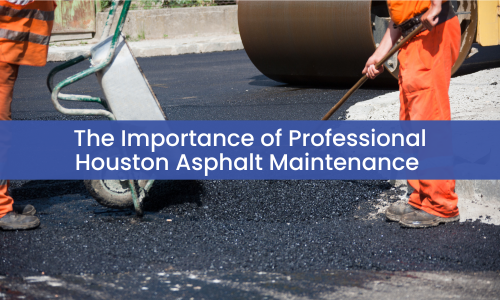Asphalt surfaces are reliable and economical for many pavement projects – driveways, parking lots and roads are all widespread examples. Asphalt’s excellent economy and reliability is only guaranteed if it’s well-maintained.
We’ve addressed asphalt maintenance many times here, but it’s worth taking a step back and explaining why that maintenance is important in the first place. That’s the subject of this guide.
Four Reasons to Invest in Regular Asphalt Maintenance
Pavement is a capital investment, and like any capital investment, taking care of it is essential to extracting maximum value. What does it mean for property owners to get maximum value from their pavement? Here are four benefits of keeping asphalt surfaces in good condition:
1) Regular Maintenance Slows Wear and Extends the Pavement’s Lifespan
Asphalt is an impressively durable material – that’s why it’s a top choice for many pavement applications. However, it’s not impervious as weather, water and wear will all cause damage to the asphalt if it’s not properly protected.
With on-time maintenance, property owners can expect 25-30 years out of their asphalt pavement. Without regular maintenance, early failure is likely. By putting off total pavement replacement as long as possible, property owners are also putting off the associated costs.
There’s another cost-related advantage here. Since maintenance slows the rate of wear, cracks, potholes, and other forms of damage will emerge gradually. This gives property owners time to catch those problems early and schedule repairs before they get worse. Multiple transportation agencies have done the research and have determined that every dollar spent on maintenance early on will save the owner several dollars in extensive repairs down the line.
If maximizing pavement value means minimizing upkeep costs during its lifespan, then on-time maintenance is the way to capture that value.
2) Asphalt Maintenance Protects Vehicles from Damage and Pedestrians from Harm
Regular maintenance doesn’t just guard the pavement from damage – it also guards those who use the pavement. Specifically, vehicles and pedestrians.
If the asphalt’s surface is in poor condition with potholes and loss of surface texture, safety hazards are more likely to emerge, and that means a greater chance of injuries or accidents.
When vehicles hit deep potholes, even at a low speed, it may cause serious damage to tires, wheels, or the vehicle’s suspension. When pedestrians walk through a parking lot, any damaged areas will be a tripping hazard to people. If someone is hurt on your property, the potential legal ramifications can be extremely costly. The hit to your company’s reputation can be extremely costly as well.
On-time asphalt maintenance can prevent those safety hazards from emerging in the first place. As a result, your pavement and your customers are protected.
3) Regular Maintenance Ensures Efficient Drainage and Protects from Water Damage
Efficient drainage is a safety issue and a lifespan issue. Standing water is asphalt’s number one threat, because with time, that water will penetrate into the pavement’s surface and intrude into deeper layers. There, moisture will eat away at the chemical binders holding the pavement together. Eventually, this slow dissolution will cause the top layers to subside, or cave in. That means bigger potholes to deal with. It also means worsening base issues that undermine the asphalt completely and necessitate total replacement.
Regular maintenance, like sealcoating and pothole patching, will shield the asphalt’s surface from moisture and slow water intrusion. The goal is to limit the number of access points for the water to penetrate through, and while maintenance alone won’t ensure proper drainage, it’s an essential step.
4) Asphalt Maintenance Also Protects the Surface’s Appearance
Pavement is definitely function over form, but it’s important for property owners to remember that their pavement helps make the company’s first impression. It’s one of the first things visitors and customers will see.
Asphalt maintenance – sealcoating and the occasional restriping in particular – is vital for also maintaining the pavement’s look. Sealcoating, overlays, and restriping all restore the asphalt’s appearance to its initial state, giving it that fresh, jet-black color that people associate with new pavement. And restriping restores the original markings, whether they’re parking lot stripes, road stripes, fire zones, loading areas, handicap markings, arrows, speed limit markings, or other high priority marks.
The quality of a property’s pavement factors into its curb appeal. On-time maintenance helps support it further.
Asphalt Pavement is Reliable if it’s Kept in Good Condition, and a Houston Asphalt Contractor Can Help with That
From the moment asphalt pavement is installed, there is maintenance to be done. Sealcoating, for example, is recommended following asphalt placement and every 2-3 years thereafter, depending on expected traffic loads.
Then there’s crack sealing and pothole patching – both of which are needed as soon as cracks or potholes emerge. Eventually, the entire pavement surface may need to be pulverized and replaced – a process known as overlaying. Chip sealing and fog sealing are alternative surface treatments.
When the pavement reaches the end of its useful life, full-depth reclamation or replacement will be necessary.
At every stage of the pavement’s life, an expert Houston asphalt company can determine which forms of maintenance are appropriate and cost effective. These professionals can spot issues before they cause safety hazards or necessitate expensive repairs, all in the mission to ensure their clients get the most value possible out of their asphalt.
- HOA & Condos – How Asphalt Pavement Can Affect Your Houston Property Values - March 6, 2025
- What Certifications or Licenses Should a Houston Asphalt Contractor Have? - September 17, 2024
- Common Challenges in Concrete Construction - September 11, 2024

